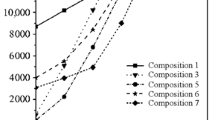Results are presented for an X-radiographic study of a cement matrix with addition of a composition of two deflocculants – sodium tripolyphosphate and polycarboxylate ester after hardening and heat treatment at 60 – 110°C. The effect of composite deflocculant on changes in concrete physicomechanical properties and heat resistance after firing at 1000 and 1200°C is evaluated.









Similar content being viewed by others
References
T. Bier, A. Mathieu, B. Espinosa, and C. Marcelon, “Admixtures and their interactions with high range calcium aluminate cement,” Presented at the UNITECR, Japan (1995).
M. N. Dunaeva, E. M. Grishpun, and A. M. Gorokhovskii, RF Patent 2331617, Refractory concrete mix No. 2006128675 / 03; Claim 08.07. 06; Publ. 08.20. 08.
B. Valdielievre, C.Wohrmeyer, and C. Parr, “Application of calcium aluminate cement (CAC) to dense low water demand refractory castables,” Presented at 9th India Int. Refractories Congr. (2012).
H. Justnes, F. Wuyts, and D. Van Gemert, “Hardening retarders for massive concrete,” 5th Int. Conf. on High Performance Concrete Location, Manaus, Brazil, 18 – 20 June 2008.
I. Pundienë, V. Antonovich, and R. Stonis, “Effect of composite deffloculant on the properties of medium-cement heat-resistance concrete,” Refract. Indust. Ceram., 50(6), 441 – 444 (2009).
I. Pundienë, V. Antonovich, and R. Stonis, “The influence of hybrid deflocculant on hardening process of refractory MCC-type castables,” Ceramic Mater., 62(3), 382 – 385 (2010).
I. Pundienë, A. Antonovich, R. Stonys, et al., “Development of refractory concrete for extreme conditions,” 15th Baltic Conf. on Silicate Materials (BaltSilica), 23 – 25 May 2011, Riga, Latvia. IOP Conference Series: Materials Science and Engineering Bristol : IOP Publishing Ltd. (IOP Conference Series: Mat. Sci. Eng., 25, 1757 – 8981), Vol. 25, 1 – 9 (2011).
Y. Fu, J. Ding, and J. J. Beaudoin, “Mechanisms of stratlingite formation in high alumina cement-siliceous material systems,” Accepted for Proc. 2nd CANMET / ACI Intl. Symp., Las Vegas, USA, June 11 – 14, 1995.
J. Ding, Y. Fu, and J. J. Beaudoin, “Stratlingite formation in high alumina cement – zeolite systems,” Submitted to Adv. in Cem. Res. for publication (1995).
H. Peng, B. Myhre, and J.-O. Roszinski, “Influence of microsilica on properties of bauxite-based castables,” Presented at the Fifth Int. Symp. în Refractories (ISR 2007), Beijing, China, April 11 – 12 (2007).
A. Hundere and B. Mihre, “Substitution of reactive alumina with microsilica in low-cement and ultra low cement castables,” Presented at UNITECR 97 in New Orleans, USA, Nov. 4 – 8 (1997).
B. Monsen and A. Seltveit, “Effect of microsilica on physical properties and mineralogical composition of refractory concretes published in advances in ceramics,” New Developments in Monolithic Refractories, 13 (1984).
B. Myhre and B. Sandberg, “The use microsilica in refractory castables,” Elkem Materials A/S, https://www.elkem.com/Global/ESM/support/technical-papers/refractories/37-e%20Use%20of%20Microsilica%20in%20Refractory%20Castables.pdf.
H. G. Midgley and R. P. Bhaskara, “Formation of stratlingite, 2CaO·SiO2·Al2O3·8H2O, in relation to the hydration of high alumina cement,” Cement and Concrete Research, 8(2), 169 – 172 (1978).
M. Palou, J. Majling, M. Dovál’, et al., “Formation and stability of crystallohydrates in the non-equilibrium system during hydration of sab cements,” Ceramics – Silikáty, 49(4), 230 – 236 (2005).
S. Bentsen, A. Seltveit, and B. Sandberg, “Effect of elkem microsilica on conversion of HAC,” Presented at the Midgley Symposium on Calcium Aluminate Cement, London, 9 – 11 July (1990).
J. Ding, Y. Fu, and J. J. Beaudoin, “Stratlingite formation in high alumina cement – silica fume systems: significance of sodium ions,” Cement and Concrete Research, 25(6), 1311 – 1319 (1995).
J. Ding, Y. Fu, and J. J. Beaudoin, “Study of hydration mechanisms in the high alumina cement – sodium silicate system,” Cement and Concrete Research, 26(5), 799 – 804 (1996).
S. Monosi, R. Troli, L. Coppola, et al., “Materials and structures/matriaux et constructions,” Materials and Structures, 29, 639 – 644 (1996).
J. Ding, Y. Fu, and J. J. Beaudoin, “Effect of different inorganic salts/alkali on conversion-prevention in high alumina cement products,” Advanced Cement Based Materials, No. 4, 43 – 47 (1996).
R. N. Edmonds and A. J. Majumdar, “The hydration of mixtures of monocalcium aluminate and blast furnace slag,” Cement and Concrete Research, 19(5), 779 – 782 (1989).
J. L. García Calvo, M. C. Alonso, A. Hidalgo, et al., “Development of low-pH cementitious materials based on CAC for HLW repositories: Long-term hydration and resistance against groundwater aggression,” Cement and Concrete Research, 51, 67 – 77 (2013).
S. Goberis, I. Pundiene, and V. Antonovich, “The effect of sodium tripolyphosphate on the properties of medium-cement refractory castables based on Gorkal-40 cement,” Refract. Industr. Ceram., 46(6), 403 – 408 (2005).
Wutz, K. Degussa Construction Polymers GmbH, http://www.newchemistry.ru/letter.php?n_id=5781&cat_id=&page_id=2).
Author information
Authors and Affiliations
Corresponding author
Additional information
Translated from Novye Ogneupory, No. 10, pp. 70 – 77, October 2014.
Rights and permissions
About this article
Cite this article
Demidova-Buizinene, I., Pundienë, I. Study of the Effect of Composite Deflocculant on Changes in Physical and Mechanical Properties of Heat-Resistant Concrete During Heat Treatment. Refract Ind Ceram 55, 480–486 (2015). https://doi.org/10.1007/s11148-015-9748-x
Received:
Published:
Issue Date:
DOI: https://doi.org/10.1007/s11148-015-9748-x




